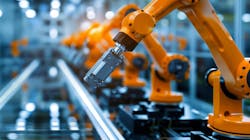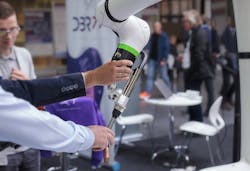AI’s Impact on Robots in Manufacturing
Artificial intelligence (AI) and automation technologies – broadly known as Industry 4.0 – are transforming the manufacturing landscape and redefining what is possible for manufacturing operations to produce and for businesses to accomplish. Today, AI-driven robots are the new must-have technology for manufacturers. These highly programmable systems are driving automation further, optimizing workflows, increasing efficiency, reducing downtime, and boosting throughput.
How AI Is enhancing robotics?
Since the first industrial robots were deployed in the 1960s, use of robots in manufacturing and warehouses has advanced and evolved significantly. Older robots were used to automate simple and monotonous tasks, but the integration of AI has taken the program in a new direction.
Today, AI-driven robots work collaboratively with human workers, significantly improving operations. With more intelligent and responsive processing systems, these robots are more responsive and can complete more complex tasks. This tune-up is largely thanks to AI’s ability to process large quantities of data, enabling these systems to make informed decisions regarding production workflows and quality control.
Workers also can use real-time data these robots collect to inform and guide their actions or decisions. This process allows for a more adaptable manufacturing environment where both humans and robots can handle tasks with greater efficiency and accuracy, working together to drive production and innovation.
Advantages of AI-driven robots
The impact AI-driven robots are having on manufacturing is deep, enabling smarter, faster, and more resilient production lines.
Efficiency. Unlike human workers, robots don’t need breaks and are programmed to focus on a specific task. Their focus and resilience enable them to work 24/7 if necessary without interruptions, reducing downtime and speeding up production processes.
Robots also have superior accuracy when completing tasks, which means they can get the job done exactly as it’s supposed to do without faltering, leading to fewer errors. They also can provide real-time data, so managers can intervene when an issue is detected.
Safety. Many warehouses and manufacturing plants handle heavy machinery and hazardous materials. Instead of putting human workers at risk, robots can do the heavy lifting and tackle the more dangerous tasks, helping reduce accidents. Some robots can even monitor the floor and send alerts when a dangerous issue has been detected.
Labor costs. While robots do not typically replace human workers entirely, current technologies allow them to work alongside humans, increasing performance and productivity. For example, some labor-intensive tasks might typically require multiple people, but robots means the number of workers can be reduced. Because robots can get more done in less time, this also negates the need for a larger workforce – and that can help manufacturers streamline work schedules and reduce labor costs.
Job creation. Adding on to that point, with fewer workers in production positions, manufacturers can focus on hiring workers with knowledge of AI, data analysis, and robotics. This means more manufacturing jobs for higher-skilled workers who handle programming, controlling, and maintaining the robots.
Employee satisfaction. Another benefit of human-robot collaboration in manufacturing is that it allows workers to do more without overexerting themselves. Manufacturing is labor-intensive work, but with robots handling the more difficult and tedious tasks, human workers can have more time and energy to focus on tasks requiring a more personal touch. This can help to alleviate a lot of workplace stress and lead to happier, more satisfied employees.
Applications for robotics in manufacturing
Material handling. Robots can handle and transfer various types of materials, including those that are too heavy for humans or hazardous materials that could pose health risks. Because robots never get tired, they can move materials easily and consistently throughout the day, from one location to another. They also can help with loading and unloading materials onto trucks or into machinery.
Processing operations. AI-driven robots can be programmed to assist with various tasks on the production line, including welding, painting, sawing, carving, drilling, and polishing. Robots are also very precise and accurate when using materials to perform tasks, such as paint, meaning they use only the exact amount needed, which can help reduce waste and overconsumption of resources.
Assembly. Robots are particularly useful when put to work on assembly lines. Putting together various parts to make a finished product can take a lot of time, but robots can streamline this process, doing it much faster and more accurately, reducing production times and errors.
Quality control. Because they are equipped with advanced vision systems, manufacturing robots are often employed to perform inspections to improve quality control. They can identify errors and defects faster and more accurately than the average human, ensuring every part of the product is exactly as it should be before it’s shipped out.
Monitoring. Industry robots are not only used to create products but also for monitoring to improve operations and drive smart decision-making. For example, some AI-driven robots are used for inventory control, monitoring stock levels, and sending real-time alerts when something is running low and needs to be re-ordered.
Robots also can monitor for safety and provide insights on how various tasks and processes on the production line can be optimized for better performance.
Challenges of AI-driven robots
It’s common today to see collaborative robots working alongside human workers in manufacturing environments. However, while this can provide numerous benefits, it also can present certain challenges.
Safety is one of the primary hurdles to successful human-robot collaboration. Though factory robots are often used to increase safety, they also can lead to safety issues if employees are not properly trained to work alongside them. Many robots are heavy machinery; if someone gets in the way while performing a task, that person could be injured.
Communication also can be a challenge if workers have limited programming knowledge. Most robots have interfaces that allow workers to access and adjust settings as needed, but this can require some technical knowledge that’s unfamiliar to some manufacturing employees.
Employee morale. Morale is another problem that can arise when robotics are adopted. The presence of robots could lead some workers to feel like they are being replaced and are no longer valuable, which could result in lower job performance.
To address these issues, it’s important to adequately train employees to use and communicate with robots. It might also require some training to address skill gaps regarding technical and programming knowledge. Additionally, employers should make it clear that the robots are not replacing workers but are there to help them do their work more effectively.
Cybersecurity. This is another challenge to consider when adopting AI robotic technologies. As robots are digital systems, they’re connected to networks, which can make them vulnerable to cybersecurity issues, such as being hacked.
Ransomware attacks are becoming more frequent, and robots and other AI systems are susceptible. So, adopting a quality cybersecurity strategy that includes ransomware protection is important. Such a strategy should involve multi-factor authentication protocols, regular data backup, and ensuring only select individuals have permissions and access to robotic controls.
The future of robotics in manufacturing is promising as AI technologies become more intelligent and more advanced. However, before adopting these systems, it’s important to thoroughly understand the challenges of implementing AI so they can be addressed accordingly. Successful integration of industry robots requires a thoughtful plan that keeps business goals, as well as safety, security, and the needs of human workers, in mind.
Ainsley Lawrence is a freelance writer and editor.
About the Author
Ainsley Lawrence
Ainsley Lawrence is a freelance writer and editor.


